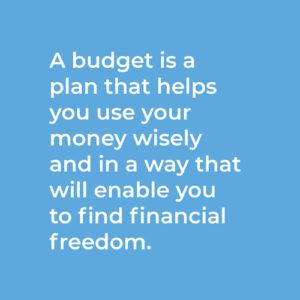The process of getting yourself to a place where you feel in control of your money can feel intimidating, especially if you are currently finding things tough going financially. But to work towards being in a place where you are managing your finances well is one of the most empowering things you can do in your life. Being able to leave financial stress and pressures behind is truly awesome!
To do this, you need to take seriously that word so many of us dislike… “budgeting.” Some people don’t like the idea of living within a budget but far from being restrictive, the power of planning your finances is that it can bring incredible freedom.
What is a budget?
 A budget is a plan that helps you to use your finances wisely and in a way that will enable you to find financial freedom. A budget gives you a clear picture of your income, expenses, and spending patterns, allowing you to make informed decisions and avoid financial stress.
A budget is a plan that helps you to use your finances wisely and in a way that will enable you to find financial freedom. A budget gives you a clear picture of your income, expenses, and spending patterns, allowing you to make informed decisions and avoid financial stress.
Here’s a step-by-step guide to creating a budget that works for you. Just remember, if you need help implementing these steps, or you need some inspiration to get going, or if you feel like your finances are in such a mess right now that you can’t work out where to begin, you can contact Visionwest’s Money Mentors team – budgeting@visionwest.org.nz.
Seven Steps to Managing your Personal Finances
Step 1: Set Financial Goals
Before jumping into numbers, think about what you hope to achieve; what are your goals? It could be you are saving for a deposit on a house, or you have debt you need to pay off, or you are wanting to build a saving account.
If you define your goals, it will give you a reason to budget and will help keep you motivated.
Once you’ve listed your goals, break them down into short-term (within a year), medium-term (one to five years), and long-term (five years or more) goals.
As an example, your goals might be:
- Short-term goal: Build a $1,000 emergency fund.
- Medium-term goal: Pay off $5,000 in credit card debt within two years.
- Long-term goal: Save a house deposit.
Now that you know what you’re working towards, you have something to aim at. That will help you make smart spending choices and maintain your savings focus.
Step 2: Track Your Income and Expenses
The next step is to understand your cash flow. That is, you need to know how much money is coming in each month and how much is going out.
To do this, list all your income sources. Make sure you include your salary, any benefits you are receiving, plus any rental income, or any other money you are receiving. This needs to be after-tax income because that’s the amount you are receiving in your hand and have available to spend.
Next think about your monthly expenses. Typically, these will include:
- Fixed expenses: Rent, mortgage, car payments, insurance, and any other costs that remain the same each month.
- Variable expenses: Groceries, utility bills, gas, and other costs that are unavoidable, but which can change month to month.
- Discretionary expenses: Entertainment, dining out, and things you spend money on but are not essential.
You can track these manually but there are also budgeting apps available, e.g., Mint or YNAB (You Need a Budget). Some of these link directly to your bank accounts and automatically categorise your expenses making tracking your expenses easy. The goal is to discover exactly where your money goes each month.
Stacey was apprehensive about letting someone advise her about her finances because she thought a budget advisor would dictate what she could do with her money. Her first visit to Visionwest Money Mentors changed both her mind and her life. Read her full story here.
 Step 3: Begin to Monitor your Spending
Step 3: Begin to Monitor your Spending
This means being aware of what you are spending and where you are spending it.
People use different methods for achieving this. Some people use what is called the 50/30/20 Rule where they allocate 50% of their income to needs, 30% to wants, and 20% to savings or debt repayment. This method is simple and flexible and means you can proactively save or reduce debt.
Other people use an envelope system where money an amount of money is set aside for a given use, e.g., groceries, petrol, etc. Once the allocated money is spent, you stop spending in that category until the next month. This is called the “envelope system” because people used to use cash placed in physical envelopes. These days, the same method can be used by manually keeping track of online spending each month.
If you have a financial mentor, they will be able to help you set up a method to manage your finances; contact Visionwest’s Money Mentors team – budgeting@visionwest.org.nz.
Step 4: Reduce Expenses Where Possible
There are some expenses that cannot be avoided – they are fixed, e.g., rent or mortgage repayments. Other expenses are unavoidable but, by being careful, they can be reduced, e.g., power or water consumption. And then there are the things we spend money on non-essentials. Those are the things that we don’t really need; these are sometimes called luxuries.
Whatever the type of expense, once we start tracking where our money is going, we can see places where we are overspending. So that you stick within your budget, look for ways to cut back on non-essential expenses, such as:
- Groceries: Yes, groceries are essential, but by being careful, we can cut back on how much they cost us. Plan meals, make a shopping list, and avoid shopping on an empty stomach to prevent impulse buys.
- Entertainment: Instead of dining out, consider having friends over for a potluck or explore free local events.
- Subscriptions: Reevaluate monthly subscriptions you don’t use often, such as streaming services.
Another effective strategy is the 30-Day Rule for discretionary purchases. If you see something you want to buy, wait 30 days before purchasing it. This helps curb impulsive spending and ensures the purchase aligns with your priorities.
Step 5: Build an Emergency Fund
One of the most common ways people fall into debt is that they have an unexpected expense such as medical bills or their car breaking down or their washing machine packing up. That’s why it’s important to set up an emergency fund to cover unexpected expenses. Make it your goal to have at least three months of living expenses in your emergency fund. Even if it takes time to build up, starting small is better than not starting at all.
Consider paying into a separate bank account by automatic payment each month so that you are consistently setting money aside.
Step 6: Review and Adjust Regularly
Your budget will change as your financial situation and goals change. Set aside time each month to review your spending, evaluate your progress, and make any necessary adjustments. For example, if you get a raise, you might allocate more toward savings or debt repayment or, if you have paid off a debt, keep setting the money aside and use it to build up an emergency fund.
A reality for most of us is that we are only two or three critical incidents away from finding ourselves in a place where we are struggling. That’s what happened to Verna who, with little warning, found herself without a job or a place to live. Read her full story here.
 Step 7: Reward Yourself for Progress
Step 7: Reward Yourself for Progress
It’s not always easy sticking to a budget. One danger is that we get tired of having to watch our money and so, one day think, “Blow it! I’m just feel like buying something!” That’s why it’s important to budget in some treats and to celebrate milestones along the way. The things you reward yourself with don’t have to be extravagant; they can be something as simple as treating yourself to a favourite coffee or enjoying a movie night at home.
By recognising your progress with simple rewards, it can make budgeting feel less like a chore and more like an investment in yourself and your future.
Final Thoughts
Many people reject the idea of budgeting because it seems restrictive, but most people who try it find that it’s actually the opposite. When we have a clear view of our finances, we’re able to make intentional choices, align your spending with your values, and work toward financial security.
By following these steps, you’re setting yourself up to reach your financial goals, reduce stress, and gain a sense of control over your money. Believe it or not, most people who stick to a budget find that they have more spending money, not less.
Remember, creating a budget is the first step; sticking to it and making adjustments along the way is how you’ll truly see results. Embrace the process and watch how it transforms your relationship with money.
If you think you would benefit from financial mentoring, contact Visionwest’s Money Mentors team; Phone (09) 818 0714, Email budgeting@visionwest.org.nz.
